The Drones of the Future May Build Skyscrapers
Innovative architects are experimenting with small unmanned aerial vehicles to prove that drones can do more than cause destruction
![]()
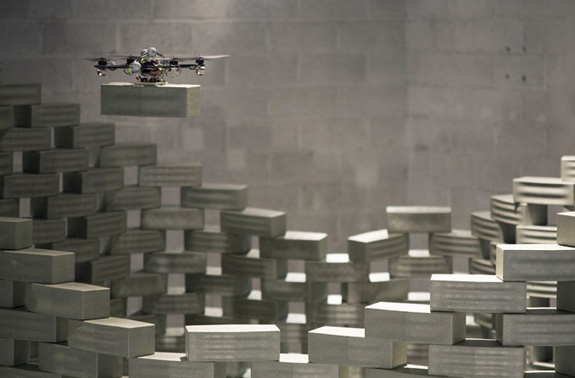
Gramazio & Kohler, Flight Assembled Architecdture, FRAC Centre in Orléans, France, 2011-2012 (image: François Lauginie via Gramazio & Kohler)
Drones can’t just destroy, they can create. Although the military uses of drones are widely debated, less discussed are their potentially revolutionary civilian implications. They aren’t yet widespread, but drones are being used by hobbyists, photographers, farmers, ranchers, and they may even herald an entirely new type of architecture. Last year, Swiss architects Gramazio & Kohler, in collaboration with Raffaello D’Andrea, developed “Flight Assembled Architecture” – an experimental concept structure that employed small, unmanned aerial vehicles programmed to build.
Flight Assembled Architecture/Architectures volantes from FRAC Centre on Vimeo.
Created as an installation for the FRAC Centre in Orléans, France in early 2012, the project models a speculative construction system that integrates robotics, digital fabrication, engineering, and design. Several small robotic “quadrocopters” lift 1,500 foam blocks into a complex cylindrical tower standing more than six meters high. While these miniature construction drones act, in part, according to a set of pre-programmed parameters, they also operate semi-autonomously; they’re capable of communicating with one another and independently sensing the height of the the tower to place their block accordingly. The tower is a model for a speculative future habitat that would stand more than 600 meters tall and house 30,000 inhabitants.
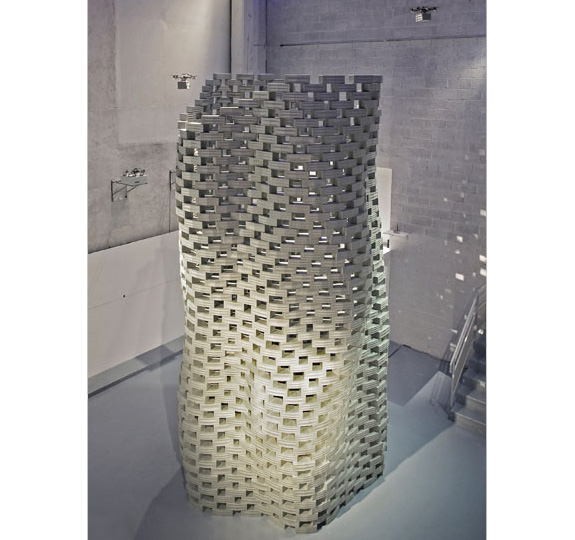
Gramazio & Kohler, Flight Assembled Architecdture, FRAC Centre in Orléans, France, 2011-2012 (image: François Lauginie via Gramazio & Kohler)
It makes sense to illustrate such a revolutionary concept with a skyscraper – after all, the skyscraper wouldn’t be possible if architects and engineers hadn’t embraced technologies such as steel construction and elevators. Construction drones are the bleeding edge of speculative building technology and they’re perfectly designed to create high-rise buildings in urban areas where construction can be incredibly difficult and costly. As Kohler noted in an essay for the architectural journal Log, “the conditions of aerial robotic construction are entirely liberated from the bottom-up accessibility of material, man, or machine.” These robots can create buildings without erecting scaffolding or using cranes. Drone-built designs aren’t beholden to current construction limitations and their use opens up a new possibility of architectural forms.
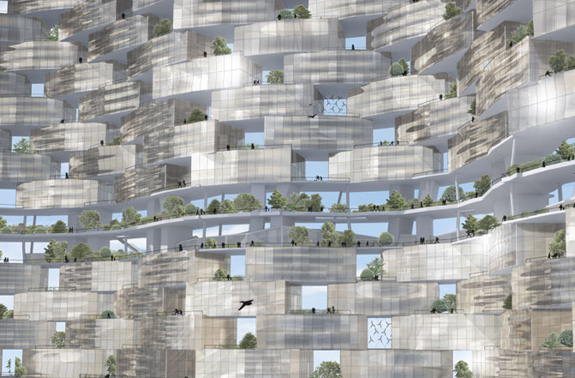
A rendering of the concept building created by Flight Assembled Architecture (image: Gramzio & Kohler)
Of course, if Gramazio & Kohler’s model were built at full-scale in the real-world, much larger robots would have to be used, and building modules would have to be designed to fit the scale and weight of the construction drones. Shipping containers, which have been widely used in architecture for some time, seem like the most convenient option, but to use containers is to limit possibility. Thinking longer term, it’s an inefficient appropriation of existing objects and infrastructure, whereas Gramazio & Kohler drones suggest a profound rethinking of building materials and assembly. Kohler writes, “As the load capacity of flying machines is limited and the machines’ agility directly depends on their load, the development of high-performance lightweight materials systems both aerially transportable and robotically deployed will be necessary.” The architects call this a “high resolution” architecture – smaller, denser, carefully calibrated, and incredibly precise.
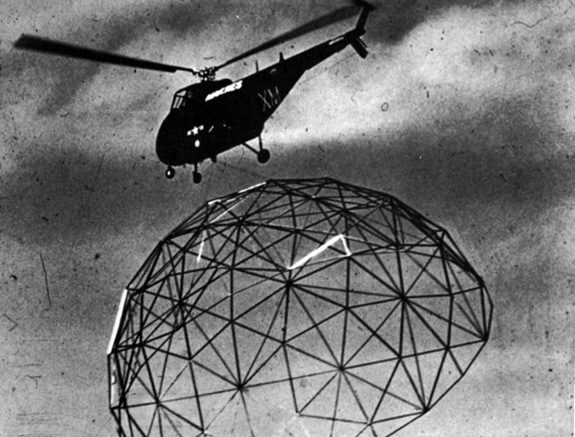
A helicopter carries a Fuller-designed geodesic dome, 1954 (image: Buckminster Fuller, Inventory of World Resources: Human Trends and Needs)
Though it sounds like something from a sci-fi future, there is precedent for air-lifted architecture. American polymath and pioneer of the geodesic dome, Buckminster Fuller developed the “Dymaxion House” in the 1920s – an inexpensive, mass-producible architecture that could be transported by helicopter and lowered onto a construction site, requiring only minimal service to install. Fuller also proposed a swords-to-ploughshares appropriation of military equipment and infrastructure to produce and construct his designs. “Flight Assembled Architecture” suggests that the same could be done with drones.
Buckminster Fuller and others like him may have provided spiritual inspiration for the project, but the programmability and versatility of flying robots presents a world of possibilities unimagined during Fuller’s time (actually, he probably did imagine them, the man was a genius). Construction drones could even be programmed with different “skills” or built specifically to perform a particular task; they could work in areas that aren’t fit for humans, aiding in disaster relief or other emergencies.
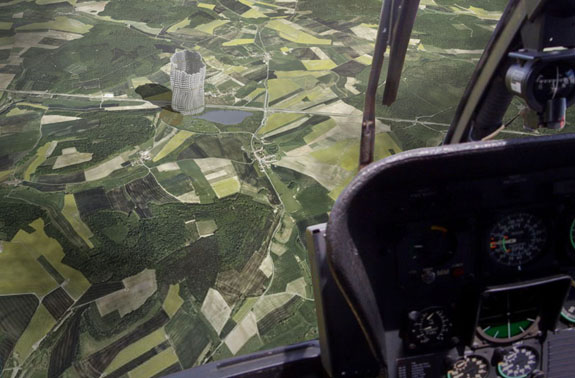
A rendering of the concept building created by Flight Assembled Architecture (image: Gramzio & Kohler)
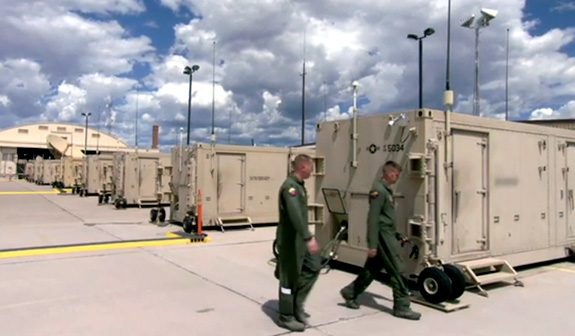
Trailers housing remote drone pilots on a military base (image: NOVA, “Rise of the Drones”)
For better or worse, drones have captured the public imagination more than any other weapon since the nuclear bomb. Harnessing the power of the atom enabled us to level cities, but it also gave us a new way to power them. Like the Bomb, the technology behind unmanned aerial vehicles can be used to destroy or it can be used to build. Today, the architecture of drones is limited to the portable, retrofitted trailers and shipping containers used by remote pilots. Tomorrow, however, drones may serve the architect instead of the solider, and herald an entirely new style of aerial architecture.
/https://tf-cmsv2-smithsonianmag-media.s3.amazonaws.com/accounts/headshot/Jimmy-Stamp-240.jpg)
/https://tf-cmsv2-smithsonianmag-media.s3.amazonaws.com/accounts/headshot/Jimmy-Stamp-240.jpg)